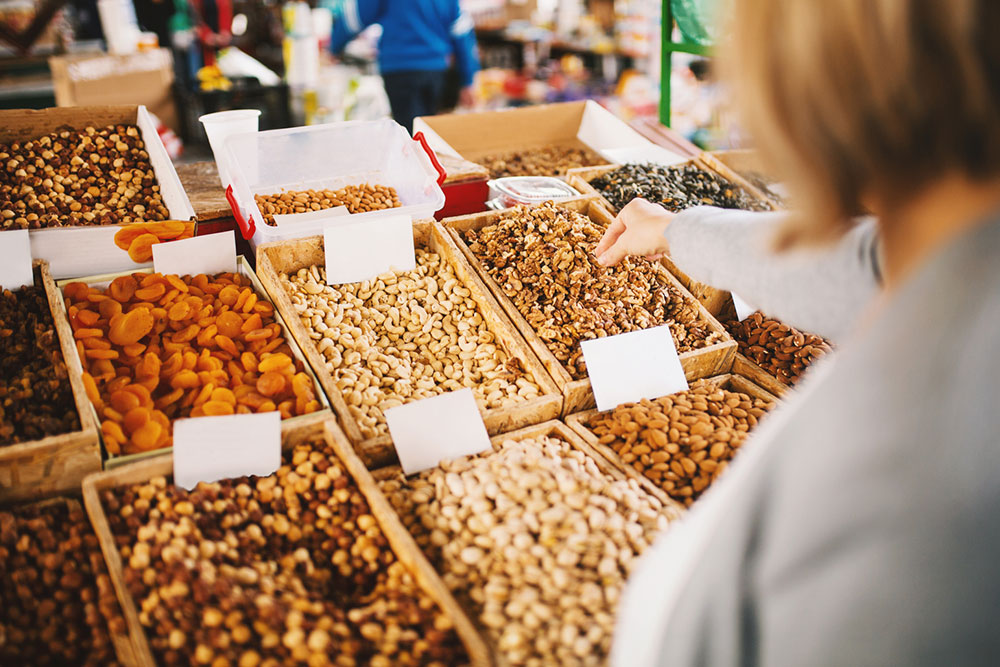Huntington’s disease – Foods to avoid and eating habits to follow

Huntington’s disease is a hereditary disease that causes the degeneration of brain cells. One of the main symptoms of this condition is uncontrollable jerky movements in the arms, legs, face, head, and upper body (called chorea). Other symptoms may also include a decline in thinking and reasoning skills, alterations in mood, and behavioral changes. This article explores how the condition impacts one’s eating and food management strategies to improve nutritional intake.
How Huntington’s affects the body and food intake
- Chorea
Huntington causes jerky, uncontrollable movements called chorea. This can use more energy, increasing one’s caloric needs. - Difficulty in planning
Huntington’s may cause short-term memory loss, making it difficult to plan meals in advance. This can also affect one’s food and nutrition. - Clumsiness
One may also experience stumbling and clumsiness. As a result, one may find it difficult to eat or drink, causing embarrassment among individuals with Huntington’s. - Mood changes
Cognitive changes with Huntington’s can cause depression and anxiety. This can cause changes in appetite, affecting one’s desire to eat. - Muscular changes
With Huntington’s, individuals may also have hand-eye coordination, eating, and posture issues. This can limit their ability to put food into their mouths, affecting their daily eating habits. Additionally, it can make it difficult to close the lips together, causing spillage. It may also cause food and drink to transfer too quickly or too slowly, affecting eating. - Dysphagia
Those with Huntington’s also commonly experience difficulty swallowing as a result of a loss of fine motor skills in the face and neck. This is called dysphagia. It can lead to an increased risk of choking, posing difficulty while eating and drinking.
In the advanced stages of Huntington’s disease, one may also find it difficult to chew and swallow. As a result, doctors may recommend tube feeding. A percutaneous endoscopic gastroscopy (PEG) tube is often inserted.
Foods to avoid with Huntington’s disease
Some foods may pose difficulties in eating and swallowing for those with Huntington’s disease. That is why individuals must avoid eating the following foods:
- Hard foods
For those with Huntington’s disease, hard foods such as nuts, seeds, chewy sweets, lollipops, and toffees can be difficult to eat. - Dry foods
Dry foods, such as sweet corn and grains, can also be difficult to chew for those with Huntington’s disease. - Stringy or fibrous foods
Foods that are split into strings or sections can also be challenging for those with Huntington’s. These include bacon, tomatoes, pineapple, celery, and lettuce. - Non-fat and low-fat products
Non-fat and low-fat products may fill one up quickly but do not provide the right caloric value. Instead of these products, individuals with Huntington’s should opt for full-fat products. For instance, a protein-supplemented milkshake is a filling replacement for a cup of black tea or coffee. - Foods with skin
Foods with skin, such as peas, grapes, and baked beans, can also be difficult to chew for those with Huntington. - Mixed consistency foods
Foods with a mixed consistency, such as soup with lumps, stewed fruit, mince with thin gravy, or muesli, can also be challenging for individuals with Huntington’s disease. To make food easier to manage, use a blender or food processor to mince meat or chicken. - Crunchy foods
Individuals with Huntington’s disease must also avoid crunchy foods such as toast, crisps, and flaky pastries, as these can be difficult to eat.
Other food strategies for managing Huntington’s disease
Managing Huntington’s disease can be difficult. One must speak to a healthcare provider for effective management strategies and the best advice. Some common suggestions given by doctors include the following:
- How to eat
Instead of eating three big meals daily, opt for smaller, more frequent meals throughout the day. Eat soft, easy-to-chew, and easy-to-swallow foods. Additionally, the consistency of oatmeal is ideal for people with Huntington. To make food easier to swallow, add gravies and sauces to the food. Add more calories to desserts by incorporating puddings, custards, creams, and ice creams. Furthermore, consume fortified foods and beverages to ensure vitamin and mineral intake. - What to do before eating
Rest one or two hours before mealtime, and create a relaxed eating environment without any distractions, such as TV or radio. Keep the mood light and cheerful, as anxiety may worsen chorea. Sit in an accessible spot on the table so aid or help can reach easily in case of choking. Additionally, keep utensils and other eating aids within reach. - What to do while eating
Always sit in an upright position while eating; do not recline or lie down, as it may increase the risk of choking. Angle the head down towards the plate. This will make it easier to swallow and reduce choking. Use non-slip table mats, plate guards, and plastic aprons to avoid spilling. Instead of metal cutlery, use lightweight versions, such as plastic knives or forks. Opt for utensils with thicker handles. To achieve this, add a layer of foam coating to regular cutlery. This will make them easier to hold. Alternatively, one can also strap the utensil to the hand. To make drinking easier, opt for a double-handed cup with a spout or use a straw secured in a plastic cup. Do not drink with a mouthful of food; the contrasting texture in the mouth could cause choking. Sit upright for at least half an hour after eating. Do not lie down immediately, as it may cause acid reflux and lead to choking.
Those caring for individuals with Huntington’s disease must watch for signs of problems with eating or swallowing, such as coughing, choking, or swallowing while eating, gurgling or a wet-sounding voice, food left in the mouth, or feeling chesty.



